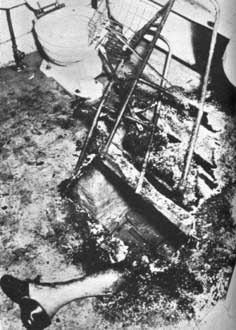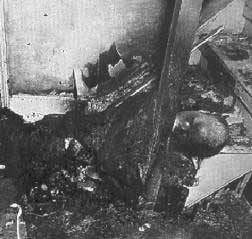On December 15, 1966, in the restroom of Dr. Bentley in Pennsylvania, a terrifying incident occurred: The floor was burned through, and next to it remained a human leg, while the rest of the doctor’s body had turned to ash. Everything in the house showed no signs of a fire. The police were baffled as to how the doctor died and concluded he must have fallen asleep while smoking, allowing the ashes to ignite his clothes.
 |
|
Dr. Bentley in Pennsylvania burned to ash in his restroom, leaving only a leg (Image: horrormagazine) |
They brushed it off as an accident resulting from a fallen ash while he was asleep.
However, a cremation expert stated that cremation requires raising the temperature to 1200oC for 90 minutes, then lowering it to 970oC for 60-150 minutes. Even under these conditions, there would still be bone ash remaining, not complete ash. The temperature of the fire was only about 800oC at most. Therefore, it was impossible for the doctor to have burned to ash in such a manner. If he had been engulfed in an intense fire, everything else in the room would not have remained intact. Scientists believe the doctor must have spontaneously ignited.
Spontaneous human combustion refers to the phenomenon where the body ignites without external heat sources, generating heat internally and turning to ash while surrounding objects remain unharmed. This phenomenon has been discussed for centuries. In 1673, an Italian medical document reported that a Parisian had turned to ash on a straw mattress, leaving only bones and some finger bones. Strangely, the mattress itself was unharmed.
Similar to this phenomenon, there are reports of humans bursting into flames. A person can ignite spontaneously, often resulting in complete incineration within minutes, posing a significant fire hazard.
In the past 50 years, spontaneous human combustion has become less of a mystery. Most recently, on May 25, 1985, in London, England, a 19-year-old named Risley was walking down the street when he suddenly felt an intense heat and then burst into flames. He suffered burns on his chest, back, and wrists, feeling as if his head was being boiled. He managed to endure the pain and ran to a nearby hospital. Due to his youth and good health, along with timely medical attention, he recovered after a few weeks of treatment.
For over 300 years, scientists have proposed various theories to explain spontaneous human combustion. Some suggest that it is related to an excess of combustible fat in the body, which acts like liquid wax. In 200 cases of potential spontaneous combustion, researchers found no correlation with gender, age, body weight, or personal habits.
Others theorize that there is some form of “electric current” within the human body that could “short-circuit” a flammable substance, leading to self-dissolution of body tissues. Some theories suggest that an accumulation of phosphorus in the body could create “non-luminous flames.” The latest hypothesis proposes that there may be “burning particles” smaller than atoms that could ignite. These theories are still under investigation and not yet conclusive.
Some images of victims of spontaneous combustion found in Italian medical documents.
Surrounding objects near the victims’ ashes were largely unharmed. (Image: horrormagazine)
|
|
|
||
|
|
|






















































